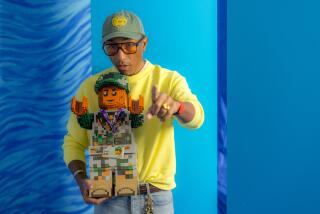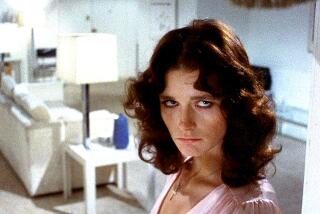Gallagher Lawson discusses creativity and his debut novel, ‘The Paper Man’
- Share via
Gallagher Lawson’s debut novel, “The Paper Man” (Unnamed Press, $16 paperback), has a striking, gutsy premise: A young man named Michael -- who is, as the result of a dreadful accident, made of paper -- navigates a mysterious, unsettling city by the sea. In addition to inhabiting the existence of this paper man and the peculiar world he moves through, the novel also delves beautifully into thorny philosophical questions about art, identity and transformation.
Lawson, who received a master’s in fine arts from UC Riverside and is also a classical pianist, currently lives and works in Los Angeles. He spoke by phone from his office in downtown Los Angeles.
“The Paper Man” sinks the reader into a world rich with dead mermaids and masks and ominous civil unrest and Michael, a man made of paper. What can you tell us about the origins?
The kernel was something real. At the time, when I was in my undergrad, I was living in Reno and then I moved to California and was on my own for the first time. I was very lonely in the city and kept seeing people I thought I recognized. I attended a lot of movies, music shows and gallery openings by myself, hoping to make new friends. And then one day I started thinking: What if I saw a painting of someone I recognized? And then I went through that whole “what if” scenario. What if I contacted the artist?
Later, in the middle of the first draft, I was kind of stuck and I was looking at a book of Francis Bacon paintings, when one really caught my eye: “Studies From the Human Body.” It has three human figures: the one on the right is outside a window, the one in the middle is halfway inside the window, and the one on the left is behind the window. I know that Bacon was against narrative interpretations of his work, but as a writer I couldn’t help give this painting a story. To me, it looked like a figure was being sucked into the painting, from the outside world into the world of art. From that I suddenly got the idea that Michael would have to be turned into art -- specifically paper. That was when the rest of the story fell into place and I was able to finish the first draft.
I’m interested to hear about the process of creating a character with such severe physical limitations. Since Michael is made of paper, he’s very vulnerable to the world and its elements.
At first it was very freeing, and I moved through a draft of the book very quickly. But when I asked others to read it, a lot of questions came up about basic things -- could he really do this? Or why wouldn’t he be affected by that? So that got me to recognize some of the limitations and got me thinking more creatively. For example, he doesn’t actually feel physical pain. So I had his vision get very blurry when physical things were happening to him. That way he recognized something was happening to his body, even though he couldn’t feel it.
I was struck by the masks Michael wears and how, as the story progresses, the masks become increasingly present (i.e. “Masks were becoming the unifying force in the city”) in the world. Where did that element come from?
Masks are fascinating to me. They’ve been a part of so many cultures and used for so many reasons. So I like the universal recognition of them. And I wanted to physically manifest the change of Michael as an initial outsider, who visibly stands out as an individual, to becoming an influencer of a society. When the people of the city start taking on masks, they are physically taking on an outsider look and normalizing it.
That mirrors Michael’s path from creation to creator as well.
Yes. Michael creates his own art with his own hands, but also creates a movement in the city by discovering his own creativity. Or by discovering more about who he is and can be.
The mysterious Doppelmann is one of several characters Michael encounters and is arguably the most important. He’s at once a fatherly and a destructive force for Michael. How do you see their relationship?
It’s definitely a tumultuous relationship. Doppelmann is the person Michael wishes he could be, and at first Doppelmann is in control of the relationship as a mentor and father figure, and Michael accepts whatever Doppelmann does. Later, as Michael becomes more popular in the city and has a reputation that supersedes Doppelmann’s, their relationship changes, and Doppelmann exhibits the unwilling passing of the torch from mentor to mentee. I think, ultimately, Doppelmann views everyone through the lens of creation and art, and Michael desires to be seen as more than that, but never really gets that from Doppelmann.
At a certain point, Michael’s desire to be truly seen creates tension between him and Doppelmann.
If I can be so bold to make a general statement about artists, writers and creative people, they are often one level removed from reality, observing it for details or whatever that can be incorporated into their art. So when an art object, like Michael, wants to be seen by Doppelmann, he can’t achieve that because Doppelmann isn’t seeing him as a person. Doppelmann is an extreme version of an artist that sees the world only for his art.
Absolutely. Doppelmann is on the extreme end of the spectrum, but we’re all a little mercenary in our way. What writers were important or influential while you worked on “The Paper Man”?
There were several works in particular that were heavy influences while I wrote the book. The play “Mann ist Mann” by [Bertolt] Brecht was one. Also, Orhan Pamuk’s “The Black Book.” Jennifer Egan’s “Look at Me.” And [Kazuo] Ishiguro’s “The Unconsoled.” All of these books had interesting takes on identity.
A little while ago you mentioned readers, and I know you did a master’s in fine arts at UC Riverside: Are your readers people you met in graduate school? Or do they tend to come from other corners in your life?
I have a few trusted friends who read portions or all of the book in various stages. But yes, once I was in my MFA program, I found a great community of people, many of whom were readers.
I’ve read that you play the classical piano seriously -- for you is there any overlap between music and writing?
For a long time I thought of them as separate activities. Often when I was stuck while writing, I would sit at the piano and play for 30 minutes to shift my focus. But recently, I’ve been looking at the ways composers structure pieces and have wondered how I could apply them to writing. I love how in music you can have a motif that can be stretched in time, placed in a different voice, or have the harmony changed. And I’m sure there are parallels to writing, I just haven’t applied them yet to my own writing. Maybe for the next book?
More to Read
Sign up for our Book Club newsletter
Get the latest news, events and more from the Los Angeles Times Book Club, and help us get L.A. reading and talking.
You may occasionally receive promotional content from the Los Angeles Times.






